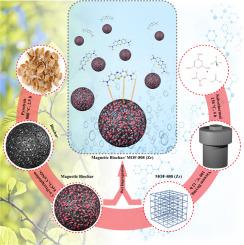锆基MOF-808负载生物质磁性生物炭:磁性纳米复合材料表征及吸附性能
IF 6.3
2区 材料科学
Q2 CHEMISTRY, PHYSICAL
引用次数: 0
摘要
本文研究了新型锆基mof -808负载磁性生物炭的合成。采用溶剂热法合成了MOF-808 (Zr),并通过湿浸渍技术将其包埋在由开心果壳生物炭(PSB)制备的CoFe2O4负载生物炭上,得到了磁性纳米复合材料(PSB/CoFe2O4/MOF-808 (Zr))。利用傅里叶变换红外光谱(FT-IR)、x射线衍射(XRD)、布鲁诺尔-埃米特-泰勒(BET)、扫描电镜(SEM)、能量色散x射线成像(EDS-Map)和振动样品磁强计(VSM)等技术对制备的材料进行了表征。通过吸附亚甲基蓝(MB)评价吸附性能。对PSB、PSB/CoFe2O4和PSB/CoFe2O4/MOF-808 (Zr)在pH为10、25℃、MB浓度为10 mg/L、吸附剂剂量为2.5、1.5和1 g/L、接触时间为60、60和80 min时,MB的最大吸附效率分别为97.78%、98.45%和99.43%。伪二阶(PSO)和Langmuir模型在拟合吸附实验数据方面优于其他模型。热力学评价表明,吸附过程是自发的、放热的。同时,K+、Ca2+和Na+离子的存在降低了吸附MB的效率。此外,所有吸附剂都保持了合理的吸附性能,经过7次吸附-解吸循环后,吸附剂的吸附效率达到70%以上。静电吸引、n-π、π-π和氢键相互作用被确定为驱动MB吸附过程的主要机制。PSB/CoFe2O4/MOF-808 (Zr)具有高表面积、丰富的官能团、快速的动力学和良好的可重复使用性,是一种有前景的废水吸附剂。本文章由计算机程序翻译,如有差异,请以英文原文为准。

Zirconium-based MOF-808 loaded magnetic biochar derived from biomass: Magnetic nanocomposite characterization and adsorption performance
This study presents the synthesis of the novel zirconium-based MOF-808-loaded magnetic biochar. The MOF-808 (Zr) was synthesized employing solvothermal techniques and embedded on the CoFe2O4 loaded biochar derived from pistachio shell biochar (PSB) through a wet impregnation technique, resulting in the magnetic nanocomposite (PSB/CoFe2O4/MOF-808 (Zr)). The fabricated materials were characterized using Fourier-Transform Infrared Spectroscopy (FT-IR), X-ray Diffraction (XRD), Brunauer-Emmett-Teller (BET), Scanning Electron Microscopy (SEM), Energy Dispersive X-ray Mapping (EDS-Map), and Vibrating Sample Magnetometer (VSM) techniques. Adsorptive performance was evaluated through methylene blue (MB) uptake. The maximum MB adsorption efficiencies were 97.78, 98.45, and 99.43 % in pH of 10, 25 °C, 10 mg/L of MB, 2.5, 1.5, and 1 g/L of adsorbent dose and 60, 60, and 80 min of contact time, for PSB, PSB/CoFe2O4, and PSB/CoFe2O4/MOF-808 (Zr), respectively. The pseudo-second-order (PSO) and Langmuir models outperformed other models in fitting with adsorption experimental data. Thermodynamic evaluations demonstrated that MB adsorption was exothermic and spontaneous. The results also showed that co-existing K+, Ca2+, and Na+ cations decreased the MB adsorption efficiency. Additionally, all adsorbents retained reasonable adsorption performance, achieving over 70 % efficiency after seven adsorption-desorption cycles. Electrostatic attractions, n-π, π-π, and H-bonding interactions were identified as the dominant mechanisms driving the MB adsorption process. High surface area, abundant functional groups, fast kinetics, and acceptable reusability of the PSB/CoFe2O4/MOF-808 (Zr) demonstrated its potential as a promising adsorbent for practical wastewater applications.
求助全文
通过发布文献求助,成功后即可免费获取论文全文。
去求助
来源期刊

Surfaces and Interfaces
Chemistry-General Chemistry
CiteScore
8.50
自引率
6.50%
发文量
753
审稿时长
35 days
期刊介绍:
The aim of the journal is to provide a respectful outlet for ''sound science'' papers in all research areas on surfaces and interfaces. We define sound science papers as papers that describe new and well-executed research, but that do not necessarily provide brand new insights or are merely a description of research results.
Surfaces and Interfaces publishes research papers in all fields of surface science which may not always find the right home on first submission to our Elsevier sister journals (Applied Surface, Surface and Coatings Technology, Thin Solid Films)
 求助内容:
求助内容: 应助结果提醒方式:
应助结果提醒方式:


